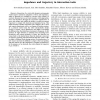Free Online Productivity Tools
i2Speak
i2Symbol
i2OCR
iTex2Img
iWeb2Print
iWeb2Shot
i2Type
iPdf2Split
iPdf2Merge
i2Bopomofo
i2Arabic
i2Style
i2Image
i2PDF
iLatex2Rtf
Sci2ools
ICRA
2010
IEEE
2010
IEEE
Biomimetic motor behavior for simultaneous adaptation of force, impedance and trajectory in interaction tasks
— Interaction of a robot with dynamic environments would require continuous adaptation of force and impedance, which is generally not available in current robot systems. In contrast, humans learn novel task dynamics with appropriate force and impedance through the concurrent minimization of error and energy, and exhibit the ability to modify movement trajectory to comply with obstacles and minimize forces. This article develops a similar automatic motor behavior for a robot and reports experiments with a one degree-of-freedom system. In a postural control task, the robot automatically adapts torque to counter a slow disturbance and shifts to increasing its stiffness when the disturbance increases in frequency. In the presence of rigid obstacles, it refrains from increasing force excessively, and relaxes gradually to follow the obstacle, but comes back to the desired state when the obstacle is removed. A trajectory tracking task demonstrates that the robot is able
| Added | 26 Jan 2011 |
| Updated | 26 Jan 2011 |
| Type | Journal |
| Year | 2010 |
| Where | ICRA |
| Authors | Ganesh Gowrishankar, Alin Albu-Schäffer, Haruno Mashiko, Mitsuo Kawato, Etienne Burdet |
Comments (0)

